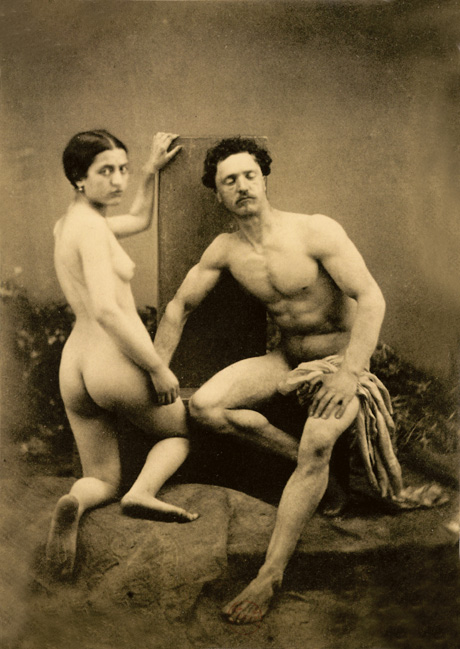| View previous topic :: View next topic |
| Author |
Message |
Nesster


Joined: 24 Apr 2008
Posts: 5883
Location: NJ, USA
Expire: 2014-02-20
|
 Posted: Wed Feb 25, 2015 6:56 pm Post subject: The Invention of Clumsiness Posted: Wed Feb 25, 2015 6:56 pm Post subject: The Invention of Clumsiness |
 |
|
Nesster wrote:
| Quote: |
| Those few words, recording a modest social occasion, also document a historical watershed: the moment when photographs defamiliarized the art of the past. Delacroix and his peers had grown up in an era when nakedness was memorialized by prints, drawings, and paintings. To their eyes, the look of photographed bodies seemed abnormal and unattractive. As of that evening though, so did Renaissance draftsmanship. Western visual culture was beginning its shift to new, less artisanal foundations. For an awkward transitional period, both new and old norms were insecure. Photography, as Delacroix put it, had begun by rendering a “detestable” service. “Without completely satisfying us,” he complained, “il nous gâte les chefs-d’oeuvre.” It spoils the masterpieces. |
http://www.cabinetmagazine.org/issues/54/worth.php
_________________
-Jussi
Camera photos
Print Photographica
|
|
| Back to top |
|
 |
philslizzy


Joined: 07 Aug 2012
Posts: 4745
Location: Cheshire, England
|
 Posted: Thu Feb 26, 2015 10:22 am Post subject: Posted: Thu Feb 26, 2015 10:22 am Post subject: |
 |
|
philslizzy wrote:
A very interesting article. Early art nudes were a fantasy of perfection in the artist's eye. Real nudes were something else - warts and all. Photographic lighting put a new perspective on them too as detail often disappeared into shadow. Shadow only seems to appear in art as a modesty preserver.
_________________
Hero in the 'messin-with-cameras-for-the-hell-of-it department'. Official. |
|
| Back to top |
|
 |
hemmo


Joined: 30 Mar 2010
Posts: 504
Location: Helsinki, Finland
Expire: 2016-12-17
|
 Posted: Wed Apr 01, 2015 4:34 pm Post subject: Posted: Wed Apr 01, 2015 4:34 pm Post subject: |
 |
|
hemmo wrote:
Interesting article. Thanks for sharing!
_________________
500px l ¿ .. ? l Jalbum |
|
| Back to top |
|
 |
JJB

Joined: 02 Oct 2014
Posts: 424
Location: USA
|
 Posted: Wed Apr 01, 2015 4:47 pm Post subject: Posted: Wed Apr 01, 2015 4:47 pm Post subject: |
 |
|
JJB wrote:
Really interesting take on the elements of perception and how different genres of representation can mutually reinforce or potentially destabilize one another.
Thanks for sharing this! |
|
| Back to top |
|
 |
fermy


Joined: 17 Feb 2012
Posts: 1974
|
 Posted: Wed Apr 01, 2015 8:01 pm Post subject: Posted: Wed Apr 01, 2015 8:01 pm Post subject: |
 |
|
fermy wrote:
Great article as a talking point. As it's all purely author's speculation, I am afraid the story linking Manet's style with photography is completely made up. The only photographic thing that I see in Manet is that terrible flat "Point and Shoot" lighting (which became the staple of poor photography much later). However, if you look at actual Durieu/Delacroix photograph, the lighting is completely classical, just technically imperfect

I have quite hard time buying the idea that at the time "nakedness was memorialized by prints, drawings, and paintings. To their eyes, the look of photographed bodies seemed abnormal and unattractive." Artists are mostly a jovial lot and they always had relatively easy access to the naked bodies, so I'm sure they knew well how the real thing looks without access to photographs.
To me the photographs of Durieu do not look very attractive, simply because I've seen many much more attractive ones. Exactly the same goes for Raimondi's engravings: the naked bodies there look strange to me not because they are too perfect, but because they neither conform to my notion of female beauty nor to my real life experience. It could be that artists of 19th century felt the same. Replace those engravings with something like the following painting, and I doubt anyone would call it "clumsy and grotesque"

I think the real role of photography in the development of painting is the huge increase in speed of spread of new aesthetic standards. Here are two "photographic" paintings. One is from 17th century, I'll let you date the other one  Anyone feels that the 17th century painting is lacking realism? Anyone feels that the 17th century painting is lacking realism?


_________________
Many lenses and some film bodies for sale here: http://forum.mflenses.com/canon-fd-minolta-md-c-mounts-m42-pentax-and-more-t50465.html
Flickr http://www.flickr.com/photos/96060788@N06/ |
|
| Back to top |
|
 |
|
|
|
You cannot post new topics in this forum
You cannot reply to topics in this forum
You cannot edit your posts in this forum
You cannot delete your posts in this forum
You cannot vote in polls in this forum
|
